| 1 | Massive gender disparity |
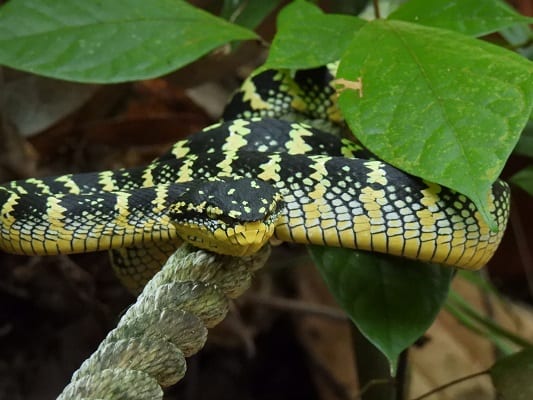
Thailand is home to 17 green pitvipers, the most common being the white-lipped pitviper. Wagler’s pitviper lives in the south of Thailand, Malaysia and Singapore, sticking strictly to forests. They measure 50-100cm, and are nocturnal, spending most of their time on branches.
Wagler’s pitvipers are just as venomous as their fellow members, but the thing that separates them is their enormous natural colour variation. The first is an extreme difference between males and females, one of the most extreme in the snake kingdom. Males are the standard leafy green, optimised for blending into foliage. There’s a bright red stripe running through their eye, with a narrower white line on its upper border. Females, meanwhile, are a dense black interspersed with neon yellow. There’s also patches of blue, interspersed with the occasional remnant green scale.
Male Wagler’s pitvipers look naturalistic, while females look technological, like the blaring colours of a TV screen in New York’s Times Square. Males and females look so different it’s hard to believe they’re the same species of snake. Females are significantly larger as well, often four times the thickness of males. When you see the two meet, it looks plain ridiculous, like the female is thinking of eating the male.
| 2 | Sharply triangular head |
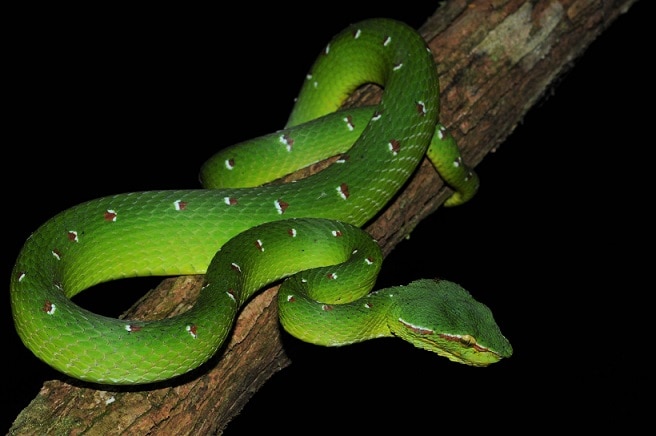
Female Wagler’s pitvipers reach 100cm, while males max out at 75cm. At birth, females are already different, as the males are spotted while the females are banded. Within months, the females acquire their new technological colours, while males stay true to their original colours for life.
Yet another difference is that females have sharper, more keeled scales. In males, they’re merely weakly keeled. Females have a neon yellow belly, while males have a white belly with a faint green tinge.
A feature shared by both genders is an extremely triangular head. Most vipers have a triangular head, but Wagler’s pitviper takes it a step further. Vertical pupils are also common to both, and orange eyes. The male version can be separated from other green pitvipers in Thailand by two features: the red-white stripe running through their eyes, and small red-white dots strewn across their body (see the picture above for a perfect example). Being so green, these dots stand out vividly. With females, there’s no trouble, as they look like no other snake in Thailand.
| 3 | Temple of the Azure Cloud |

Wagler’s pitviper is also the star of one of the greatest snake temples on Earth. The Temple of the Azure Cloud lies in Penang, peninsular Malaysia. It was constructed to honour Chor Soo Kong, a healing monk who lived during the Song dynasty from 960 to 1279AD.
Legend has it that when the temple was finally completed in 1805, legions of snakes slithered out of the nearby forests, of their own accord. These were Wagler’s pitvipers. The snakes were invited in, and today, with the temple a popular tourist attraction, the Wagler’s pitvipers crawl all over the floor inside. They rest on specially constructed wooden beams, and are left offerings by visitors: oranges, eggs, rice, melons, etc. A sign warns visitors not to poke the snakes, not because they might bite, but because it might upset them.
Naturally, people are scared of these Wagler’s pitvipers hanging from the roofs, but a constant scent of incense hangs in the air, which is burnt to mollify the snakes, apparently succeeding (if you listen to the monks). Another theory is that as the Wagler’s pitvipers eat so much during the night, scoffing down the tourists’ offerings, they’re too exhausted to do anything but lie down during the day. Consequently, another name for Tropidolaemus wagleri is the temple pitviper.
| 4 | Occasionally climbs to 15 metres |
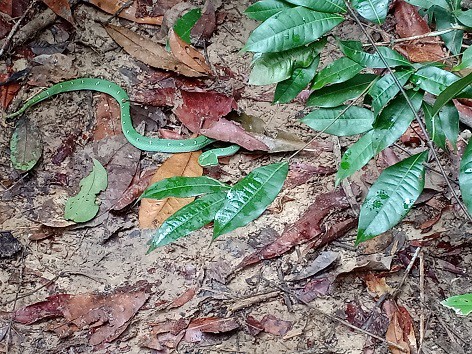
Wagler’s pitvipers appear in a variety of forest types: mangrove, swampy forest, hilly forest, rainforest. They’re excellent climbers, and generally prefer heights of 1-3 metres above ground rather than towering in the sky, yet they can stray to 15 metres above ground, if lured by the tantalising scents of prey.
Wagler’s pitviper can remain on the same bushy perch for a week, digesting their previous meal. They’re a sluggish snake, staying still for most the day, rather than darting between branches like a ninja. With their striking yellow patterns, and the fact that they’re at eye level, female Wagler’s pitvipers are easy to spot, while the green males are trickier. They don’t normally react, but if they decide to attack, their strike is lightning quick, contrasting against their normal sluggishness.
It’s rare to see Wagler’s pitviper on the ground. Unlike the white-lipped pitviper, they’re never abundant in human-occupied territory. The former appears in overgrown alleyways of Bangkok, but Wagler’s pitviper is strictly a forest species. They can fasten onto branches with a prehensile tail, and extend their upper body into thin air, as they probe scents, before pulling back again and spending another few hours as still as a statue. This snake mainly lives from 400 to 800 metres, and very rarely above 1200 metres.
| 5 | Unusually neurotoxic for a viper |
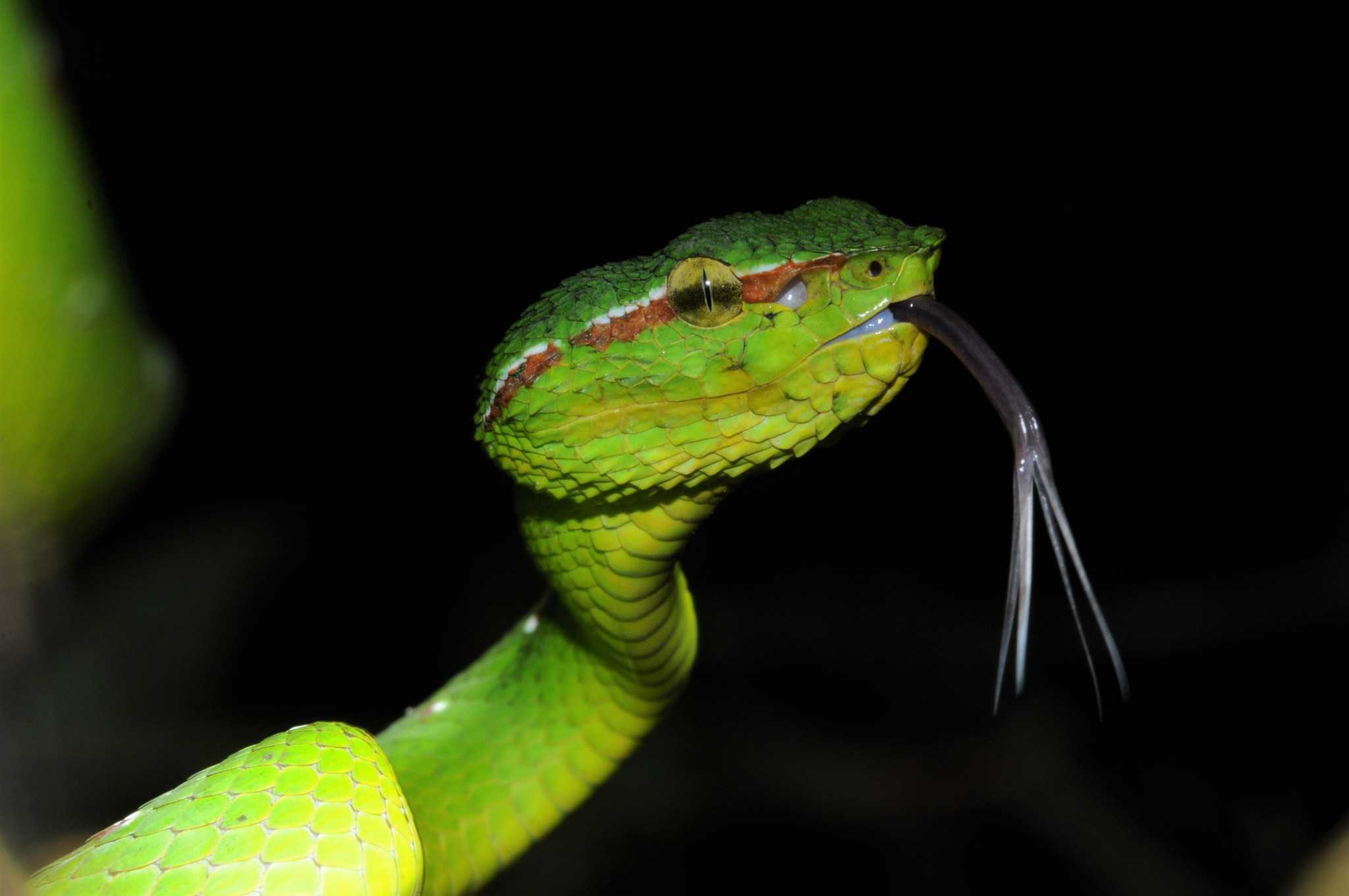
Wagler’s pitviper isn’t a rampaging terror, but causes a decent chunk of bites in its realms. A Malaysian survey found that from 2015-2021, 310 patients arrived in hospital suffering from snakebites from the Tropidolaemus family. 120 of these were T. wagleri, all of which were on peninsular Malaysia. The other 190 were its close relative Tropidolaemus subannulatus, all on the islands of Sabah and Sarawak.
As you’d expect from a branch dweller, the upper limb was bitten in 56.6% of cases. Pain was experienced in 77.1% of victims, swelling in 27.2%, which is low for a green pitviper. The reason: this is a primarily neurotoxic snake. Most green pitvipers of Thailand are weak for neurotoxins – they specialise in haemorrhaging and necrosis. Neurotoxins are the specialities of cobras and mambas, not vipers. Wagler’s pitviper is a rare beast to target the brain.
The specific neurotoxin is waglerin-1, which blocks acetylcholine receptors in muscle cells from receiving brain signals, eventually causing paralysis. This is the same process as with black mambas. Until azemiopsin was discovered in Fea’s viper (China), Waglerin-1 was the only ACh receptor blocker known in the viper family.
| 6 | Produces 6 rare toxins |

Waglerins were named for this species, as they’re a toxin found in no other snake. The venom contains 6 types of waglerins, making up 38.2% of total proteins within. Less abundant toxins include phospholipase A2, serine proteinase, snaclec and metalloproteinase. When mice are bitten, they experience laboured breathing and ultimately paralysis.
Exactly why there’s 6 separate waglerins is unknown. But we have a clue, as one study injected rats with waglerin-1, and found no effect on breathing. The rat easily survived, while a mouse died rapidly. Each waglerin may specialise in different prey categories.
In 2014, an antivenom was tested against various vipers it wasn’t designed for, including Russell’s vipers and Malayan pitvipers. It worked well, due to crossover in toxins between species. But there was one snake it failed for – Wagler’s pitviper, because of its unique toxin profile. Luckily, these waglerins aren’t strong enough to affect humans. It’s common to have paraesthesia, tingling across the body, but bites never progress to paralysis. Wagler’s pitviper also has anticoagulant properties, weakening blood clotting by depleting fibrogenin supplies. However, these are negligible compared to other green pitvipers.
| 7 | Has a glowing tail |
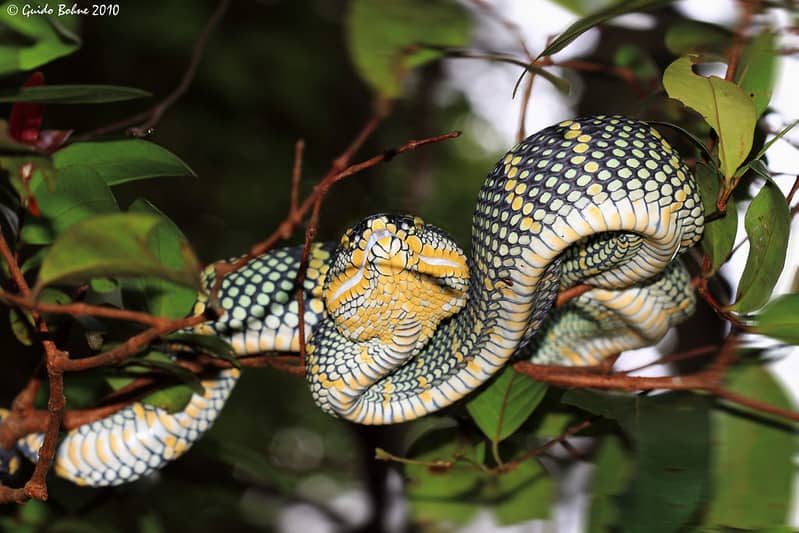
Another secret of Wagler’s pitviper lies in its tail, the very tip. In normal light this tail is pale green, somewhat lighter than its body. However, under a microscope, it transpires that its tail tip is fluorescent, absorbing photons and reemitting them in longer wavelengths. This causes them to glow in darkness, and the theory is that this mimics fluorescent insects, luring in the prey that feed on them.
With its immobile branch perch, this is a perfect strategy for luring prey without doing anything. Wagler’s pitviper waggles this tail to mimic a juicy insect in motion. They also keep this fluorescent tail tip into adulthood. Not all Asian pitvipers have this skill – McGregor’s pitviper completely lacks it, as does the Ceylon pitviper.
Hagen’s pitviper and the Sumatran pitviper (Trimeresurus sumatranaus) are another pair to have a handy fluorescent tail, and all the hunting advantages that come with it. It’s a lucky roll of the dice – Wagler’s pitviper was blessed with this skill, and received a rare batch of neurotoxins. There’s no predicting what goodies mother nature will hand out and to who.
| 8 | Rarely found outside forests |
Wagler’s pitvipers ranges from southern Thailand to peninsular Malaysia, Singapore, and Indonesia. There’s also an isolated population in southern Vietnam, cut off from the rest.
In Singapore, it’s abundant in the Central Catchment and Bukit Timah Nature Reserves, two spots with old primary forest remnants. In Thailand, they’re especially common near the tourist seaside city of Phuket. Wagler’s pitvipers need moisture to survive. They’re never found in dry scrub forest and in their rainforests, they’re particularly common by small flowing streams. Here, they’re just as still and immobile as ever. Wagler’s pitvipers stray to the ground occasionally, more common just after heavy rainfall. Newborns spend more time on the ground than adults, while they wait for their climbing skills to fully bloom.
Wagler’s pitvipers lays live young, with up to 41 reported. Its diet has never been analysed in detail, but most reports from the wild mention rodents first and birds second, with geckos and frogs as a backup. Geckos have been recorded, and if disturbed while eating, they’ll regurgitate their prey immediately. The signs suggest that Wagler’s pitviper has a flexible diet.
| 9 | Used in cosmetics |
Wagler’s pitviper has a relatively short strike, just 0.3 metres in distance. They vary in temperament – some will bite readily, while others need to be repeatedly provoked. Fortunately, they don’t strike without warning, as they normally coil into an S-shape first. Wagler’s pitvipers can strike several times in succession, and the strike itself is rapid. This snake has such supreme balance that they can rest on a vine 1cm in diameter.
One weird quirk of this species is that its waglerin neurotoxins were once used in cosmetics. A Swedish firm manufactured Syn®-ake, advertised as “Botox-in-a-bottle”, which featured waglerin-1 as a prime ingredient. The ingredient particularly took off in Korea, and the websites featured pictures of fierce snakes, although none were actually Wagler’s pitviper.
The neurotoxic proprieties are actually the magic. Supposedly, reducing microcontractions of muscle on the skin surface can cause a significant smoothing effect, noticeable within 28 days. This is claimed to firm the skin around the eyes, forehead and mouth.
| 10 | Tales from captivity |
Wagler’s pitvipers get stressed easily when plucked from their natural forest habitat. They used to be uncommon in captivity, and die for seemingly no reason. According to this old 1980s report, there were 50 Wagler’s pitvipers kept in the Netherlands, yet all but 4 had died when the author corresponded with the owners.
Younglings are especially difficult to feed, and the forcefeeding used with other snakes can kill this species. This author was far more successful, raising two, forcing one of them just once. His trick was to cut mice into small pieces, and thrust them at the Wagler’s pitviper’s mouth so that it bit down in surprise, and was then forced to swallow.
After a year, the Wagler’s pitvipers had grown from 18cm to 27cm. For the next 18 months, they happily ate a pinky mouse every 1.5 weeks, and grew to 43cm. The keeper succeeded where others failed for two reasons: choose a smaller cage (30x20x25cm), and keeping a lower humidity level of 65-70%. The other Netherlands keepers stuck to 90%, while their cages were so large that the Wagler’s pitvipers failed to locate their food. Nowadays, Wagler’s pitviper is more common in captivity, but they’re still harder to keep than a corn snake, and can stop eating for no reason. The record lifespan in captivity is 14 years.
